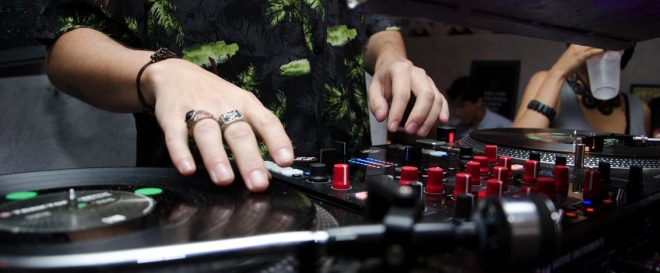10 Ideas Which Will Make You ‘The Guy Whose Parties Totally Rock’

To really make college life the time of your life, you can’t just play it by ear. Sure, sometimes you can be spontaneous, but on other days you’ve got to plan the hell out of these kinds of things. Yeah, that does sound like a lot of work, but whoever said being popular was all fun and games? Trust me, making waves is hard work.
Of course, if you do manage to pull it off, that will make your life infinitely better. So what are some of the most important things that you need to make sure you do so that your parties will have that extra bit of excitement and energy?
Guys and girls at parties
Lesson number one, girls will often flake. That’s just a fact of life. I can’t explain why they do it, but they do. Lesson number two, most dudes won’t bring women. They just don’t. Instead, they’ll bring more dudes. That’s who they know. That’s who they’ll bring.
And as you well know, if the sausage factor at a party gets too high, then it’s over. You might as well be playing video games.
Don’t let that happen. Don’t throw a party unless you’re sure that you have at least as many women as men saying they’ll come.
In fact, focus all your attention on getting them to come (Though don’t be creepy about it). For where the women go, the men will follow. That’s why ladies nights are always packet in bars.
Get-togethers are a good start
In fact, why not start with something small. It doesn’t immediately have to be the biggest party on campus. If you have something smaller you can still have a lot of fun. What’s more, because it’s intimate and everybody knows that there are only a few people coming, they’re less likely to flake because they know it affects everybody else.
A common strategy I use is to have a pre-party with a bunch of cool people. Then, after we’re all in a good mood (read: roaring drunk and laughing like crazy) we’ll hit a bigger party. Everybody who was at the get together will talk to their friends about what a great time we had.
Then, just rinse and repeat. Rumors will spread. More people will want to come. And before you know it, you don’t even bother to find parties anymore as everybody’s coming to your place instead.
Party props
Yeah, of course you can entertain people with jokes, comments and crazy talk. Still, everybody can use a helping hand. For that reason, a great idea is to strategically place party props all over the place.
Here I’m talking about wigs, masks, moustaches, loud clothing items, hats, water pistols, helium balloons and anything else people will be able to play with. You don’t have to tell people about them. Just leave them there. In that way, you won’t force people into fake frivolity.
Instead, when they feel like it, they’ll grab something and put it on. As soon as one person starts, generally other people will follow and try to outdo each other. That will create laughter and amusement all around – which can really liven up a party.
Even better, they’ll want to take pictures of each other dressed up in crazy outfits doing crazy things. These go up on social media and without any extra effort on your part, news of your great parties will spread.
Don’t invite the creeps and get rid of them when you do
There are always a couple of guys that the girls really don’t like. The don’t make them feel safe or comfortable. You’ve got to find out who these people are and either get them to change how they’re behaving or not invite them.
The only way you can find out who the creeps generally are is by listening to what the women have to say. At your party, always ask people if they’re doing okay and if the vibe is good. If they hesitate, press them gently on it.
Now, to be clear, some girls and some guys just don’t get along. That’s not a reason to throw the guy out. What you’re looking for is the guy that lots of girls don’t like or feel comfortable around. These are the creeps and they can make your party end very quickly indeed. The reason is that guys are just physically a lot stronger than guys and women know this. And so, rather than risk a confrontation, they’ll generally prefer leaving and going somewhere else.
If you can, throw them out. If that will cause too much of a scene there’s always the tequila trick. It’s straightforward. Enlist the help of one of the girls that he’s freaking out – preferably one he has the hots for. Set up a line of tequila shots. Then have the girl challenge the guy to a race.
The trick is to give the girl really weak shots (a tiny bit of tequila and the rest water) while he gets full strength ones. They go one for one. She should act like it’s hard for her, but keep challenging him to another one. Soon he’ll be too drunk to creep anybody out. It might be a good idea to keep a bucket handy.
Alcohol stashes
The more alcohol people see, the faster they will drink. And as they often don’t know their limits yet that can get ugly fast. This is particularly true of women, who are less likely to have a lot of drinking experience, are more affected by alcohol anyway and have less body weight to absorb it. That means they get drunk more quickly.
And you really don’t want to spend your whole evening holding their hair out of the toilet (or watching a whole group of girls troop off to take care of their friend).
The solution is to ‘ration’ the alcohol. Hide your supply in different places and then bring it out just as what’s there is about to run out. This is particularly important to do with the hard liquor, as people are far more likely to shoot this and get too trashed.
Even better, if the party is falling apart, then you don’t have to reveal another stash. Instead, you can just say you’re out and let the party die (or let some of the excess baggage go look elsewhere for a party).
Food if vital
Also, to help your party lasts, make sure people eat! A great idea is create huge pans of food that you can easily warm up and serve out to people. The food will help give them a base, absorb a little bit of the alcohol and keep the party going longer.
No, chips are not a good substitute.
Alternatively, if you’ve got a big enough party, then why not talk to a local food vendor with a truck or cart? Tell them about your party and find one that’s willing to come by at about dinner time and sell tacos, fries, hot dogs or whatever else.
Both your guests and the vendor will thank you for it. What’s more, people won’t drift off to eat when they get hungry.
Sunday Sessions
Sundays are difficult days to party like crazy because often everybody has class early on Monday. The Australians came up with a great solution. Just have the party earlier! If, instead of starting at 10, you start at 4, the party will run down by about 10, midnight or at the latest 1 or so.
That means, you’ve all had a great party and yet you haven’t made it impossible to show up for class. In that way you’ll actually attend and can get some help that – if you’re a real party animal – you might well need.
That means, you’ve all had a great party and yet you haven’t made it impossible to show up for class.These parties work especially well with another great Australian tradition: Barbeques!
Introduce everybody to everybody
Always do this. It doesn’t even have to be your party. Do this when you’re out. Do this at a funeral (just more quietly). Just as importantly, if you see any point of commonality between the two people, make sure they know about it!
Do they both like music? Are they both into football? Do they both hate Trump? Great! Let them know as then they’ll have an introductory topic and from there the conversation will generally flow freely.
Note that you’re not just doing this to make the party you’re at work. You’re also doing this to be known as ‘that guy’ (or girl). The person who people remember for introducing them to their new friends or partner. The person that makes it easier to be around new people. The social butterfly. Once you’ve got that title, you’ll be a must to bring to parties and everybody will want to know you because you know (And will introduce them) to everybody else.
Don’t have a screen on
Men are horrible with screens. Maybe it’s because they were hunters back in the stone ages, but when something moves, they want to watch it. So don’t have one. Unplug any TVs you have and wrap a bunch of tape around the plug, to make it impossible to plug in.
That way, people will focus on the party rather than on the game.
Include the neighbors
If you’re throwing a party then invite the neighbors. This will make sure that they are far less likely to complain if the party keeps going too late, even if they don’t show up (they’ll have more good will towards you). And besides, when they then have a party, they’ll be far more likely to invite you.
Besides, it’s nice and you want your neighbors to think you’re nice.
In this article, we’re going to explore the drawback of alcohol addiction in our everyday lives.
The Rise of Alcoholism
Alcohol consumption in the US is on the rise for the past two decades. In fact, Americans today are drinking more than before the Prohibition, and that’s an alarming indicator for the future. Since 1999 alcohol-related deaths doubled, which means the death rate jumped for more than 50 percent. The numbers show us that alcoholism, with its fatal consequences, is escalating, and the trend is not showing any signs of slowing down or stopping.
The Centre for Addiction and Mental Health, in Toronto, and the Technische Universität in Dresden, conducted a joint study on the global alcohol consumption rate. From 1990 to 2017, worldwide alcohol intake increased by 70 percent. Europe was the only exception in the world, with a 12 percent decrease.
Moreover, toxic but popular habits like binge drinking (pregaming) or “mommy juice” are normalizing high alcohol consumption and turning it into a culture.
Alcoholism & Partner Violence
According to WHO: “ partner violence refers to any behavior within an intimate relationship that causes physical, psychological, or sexual harm to those in that relationship.” And alcoholism plays a massive role in the extent and impact of the violence between partners. Furthermore, alcoholism increases the risk of becoming a victim or perpetrator.
Even though men towards women commit the highest percentage of violent acts, rates of women perpetrators and same-sex couple violence are on the rise. Alcohol consumption is often a direct cause or one of the leading reasons for partner violence.
Because alcohol disturbs the cognitive and physical function and lowers self-control, individuals are not able to reach a non-violent resolution. Furthermore, because alcoholism can be financially draining, it causes additional tension and difficulties between partners.
On the other hand, partner violence can be the reason for alcohol addiction, if the victim is using alcohol as a coping mechanism.
Alcoholism & Road Trauma
Drunk driving is responsible for more than 31 percent of all car accidents in the US. Alcohol consumption affects the driver’s ability to control the vehicle, and it alters the driver’s subjective assessment of risk. Hence, the combination of these factors is reckless driving behavior, which can result in road trauma or even death.
Depending on the amount of alcohol in the body, the driver’s ability can be impaired for hours after he or she stopped drinking. In fact, the driver’s distance and depth perception are affected, including his visual performance. The ability to process information from multiple sources is reduced.
According to a study about simulated driving performance following alcohol consumption, published by the Journal of Sleep Research, even with small amounts of alcohol in the driver, the possibility for traffic accidents doubles. Almost all countries in the world penalize drunk driving in one form or another. However, that has not affected the rising trend of alcohol-related road trauma.
Alcoholism & Mental Health
The link between alcoholism and mental health is undeniable. In most cases, specific mental health conditions like depression and anxiety are caused by alcoholism. And in other cases, mental health issues are the primary motive for developing alcohol addiction. Because people drink to improve their mood, it’s very easy to abuse alcohol as a coping mechanism.
The human brain functions in a healthy way when there is a chemical balance, and alcohol is a depressant. Hence, it disturbs the balance because it affects the neurotransmitters in the body. And by suppressing the part of the brain responsible for inhibition, it lowers anxiety, but only momentarily.
In fact, with constant alcohol consumption, the brain can’t restore the chemical balance, and the person becomes addicted. Thus, alcohol becomes a mood regulator with severe mental and physical consequences that prevent the brain from producing serotonin.
Alcoholism & Physical Health
The devastating consequences of alcoholism on physical health range from mild to deadly. According to the National Institute on Alcohol Abuse and Alcoholism, these are some of the conditions directly caused by alcoholism:
- Alcoholic cirrhosis of the liver
- Alcoholic fibrosis and sclerosis of the liver
- Alcoholic hepatic failure
- Alcoholic hepatitis
- Alcoholic gastritis
- Fetal alcohol syndrome
- Alcoholic liver disease
- Alcoholic cardiomyopathy
- Alcohol-induced acute pancreatitis
- Alcoholic fatty liver
However, that’s not the whole picture, and excessive alcohol consumption is listed as a risk factor for over 200 illnesses. Some of the more severe conditions include:
- Mouth cancer
- Ovarian cancer
- Breast cancer
- Prostate cancer
- Epilepsy
- Ischemic stroke
- Diabetes
- Unipolar depressive disorder
- Hypertensive heart disease
Alcohol addiction is often contributing to the aggravation of a variety of health disorders. And mild conditions can cause severe damage if they’re combined with alcoholism. The effects are both mental and physical, and the brain is the first organ in the body that suffers from the imbalance.
The Effect of Alcoholism on the Family
As with any addiction, the damage of alcoholism on the family can be devastating. Both for the partners, their children, and any additional member of the family. By putting a strain on emotional and financial stability, the possibility for violent outcomes and arguments increases. In fact, of all married couples that had issues with domestic violence, 60 to 70 percent included alcohol abuse.
Constant alcohol consumption affects the brain’s balance, which means the person’s cognitive abilities are impaired. That leaves him or her incapable of performing tasks and family obligations. Alcoholism can also result in legal issues and low work performance (unable to keep a job, stuck in low-paying jobs, or unemployed).
The effects on the family are evident when one of the family members makes drinking a priority instead of the family itself. Alcoholism leads to negligence, irresponsibility, social, health, and financial issues.
The Effect of Alcoholism on Children
Alcoholism is also a contributing factor in the escalation of child abuse. Over 700,000 children per year are victims of child abuse in the US, and in 90 percent, it’s someone related to the child. In most cases, the violence is triggered by intoxication.
Children living with alcoholic parents are in danger of physical, sexual, and emotional abuse by them or other people. Parental drinking is a risk factor mainly because the parents leave their children exposed to misuse by others. That’s due to the fact alcoholism interferes with the parent’s ability to provide a safe home environment.
One of the main issues with alcoholism in the family is the neglect and lack of care for children and their wellbeing. When children are left to their own devices, the threat of illegal or criminal behavior is also higher.
Growing up with alcoholism affects the child’s social and emotional growth, and it increases the risk factors for abuse.
The Financial Burden of Alcoholism
The financial burden of alcoholism can be quite expensive, depending on income, consumption volume, and liquor type. And even though the costs are different for everyone, the toll constant drinking takes on the account is similar.
The average American spends $565 per year on alcohol purchases or one percent of the annual gross income. However, calculating the cost for someone with alcohol addiction comes closer to a couple of thousands of dollars per year. That’s because alcohol becomes a necessity used as a mood regulator that helps with withdrawals.
Moreover, the cost related to alcoholism doesn’t end with the purchase price of the liquor. There are also possibilities for additional expenses like:
- Increased health care costs
- Higher insurance premiums
- Legal fees
And it’s harder to keep a steady or a high-paying job, which leads to an even more difficult financial situation.
The Healthcare Cost of Alcoholism
The burden of alcoholism falls the hardest on the healthcare system. And in the US, the healthcare costs for alcohol-related problems every year is about $22.5 billion. However, the total cost for alcohol-induced conditions comes around $175.9 billion per year, which is more than the cost of smoking or drug-related problems.
Moreover, 25 to 40 percent of general hospital beds are taken by people that have a condition related to alcohol consumption. And the cost for untreated cases connected to alcoholism is approximately $184.6 billion each year. Those costs are distributed across health care, business, and criminal justice. The result is over 88,000 alcohol-related deaths.
The statistics are grim, but they are a wake-up call for the modern world and the issue we’re facing with addiction. Alcoholism doesn’t affect only the individual, but the entire society from the healthcare system to the labor market.
Excessive drinking is draining the economy, and it’s putting a strain on public safety.
The Public Burden of Alcoholism
The WHO passed a number of resolutions that address the issue of alcoholism, explaining the safety measures that each country needs to take to battle the addiction. And the public burden of alcoholism is felt on a local, national and global level. The same way the consequences are felt in the family and the community.
A study published in JAMA Psychiatry showed that one in eight adults in the US has an alcohol use disorder. Furthermore, after the first decade of the 21st century, we can see a 47 percent increase in alcohol consumption across the country. Taking these numbers into consideration shows that the public burden is only going to increase.
However, it’s up to the country to take measures. And it is up to the individuals affected by this addiction to seek help.
Conclusion
Battling with alcoholism is hard for everyone involved, including society. Hence, if you’re thinking about quitting alcohol, we would recommend you to try this drug rehab in Arizona. This is a journey that genuinely begins by taking the first step and admitting the problem. And in a safe rehabilitation facility, you can get all the support and help you might need for the next steps towards recovery.
Rehab facilities, 12-step programs, and trained professionals can help guide you. Also, staying connected with family and community in difficult times is advised.
Last words
The trick to loving a party is making sure everybody else is loving it too. That won’t just pay off today, but – once you have that reputation – will pay off for all the months and years that you’re at college. People will invite you to their does, because they want to be invited to yours.
And that’s a good place to be. You won’t have to hunt. You won’t have to chase. Instead, the parties will come to you. Even better, you’ll be able to pick and choose or combine forces to create even better events.
Now what’s not to love about that?



